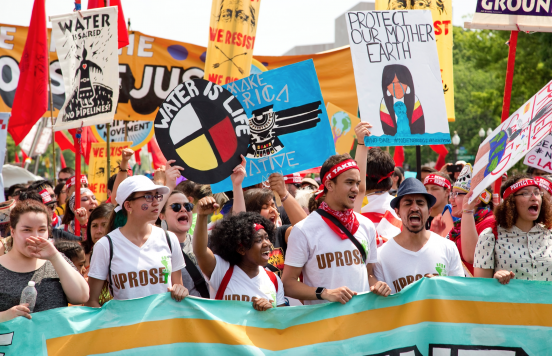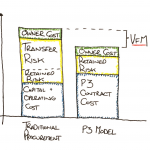The Trans Mountain Expansion Project is a policy proposal to twin the existing Trans Mountain pipeline from Alberta to the Pacific coast of British Columbia. The proposal is supported by the Alberta and Federal government but has been strongly opposed by the province of British Columbia. This opposition stems primarily from the environmental risk to marine and terrestrial ecosystems which BC feels it will unfairly bear the cost.
In order to evaluate the policy problem, a comparison will be drawn between a similar environmental case study in Australia. The two policies will be evaluated based on both the environmental and legal context to identify potential cause for implementation failure, and policy recommendations are proposed to mitigate the barriers to implementation.
BACKGROUND AND ENVIRONMENTAL CONTEXT
1.1 TRANS MOUNTAIN PIPELINE EXPANSION
The Kinder Morgan Trans Mountain Expansion Project (TMEP) is a proposal to twin the existing 1,150 km Trans Mountain pipeline from Edmonton Alberta to Burnaby on the Pacific coast of British Columbia1. Construction on the original pipeline was completed in 1953 and operated in that state until 2008, when a 158 km section of the line was expanded through Jasper National Park and Mount Robson Provincial Park2. Kinder Morgen, the Texas based owner of the pipeline, filed an application to twin the remaining length of the pipeline in 2013 which would run parallel to the 980 km of remaining line. The proposal was supported by the petroleum industry and the provincial government of Alberta but was opposed by the provincial government of British Columbia from the outset.
Interprovincial pipeline projects are under the jurisdiction of the Federal Government of Canada, and the application was approved by the federal cabinet in 2016, setting 157 binding conditions to be met over the life-cycle of the project. Forty-nine of the conditions specifically focus on environmental requirements3.
Of the stated concerns, impact to coastal ecosystems at the port raised the largest concern which also includes an increase in tanker traffic and increase in volume of transfer at the port. The second area of concern appears to be over the terrestrial impact of the expansion of the port in Burnaby which has had several major spills in the past4. The third area of concern has to do with pipeline impacts along the corridor of the pipeline right-of-way which include terrestrial impact from widening or creating new corridors, and potential release from the pipeline. The final area of concern involves the associated increase in emissions resulting from the expansion; however, BC seeks to include the ‘upstream’ emissions for production of the bitumen into the emissions calculations for the pipeline but only ‘midstream’ emissions are included in the impact study or considered by the government5. The economic liability for the cost of remediating environmental impact from all areas of concern is a large driver in the opposition, however the fundamental driver is protection of the intrinsic quality of nature and the cultural/ social benefit it provides.
1.2 AUSTRALIAN NORTHERN GAS PIPELINE
In comparison, the Jemena Northern Gas Pipeline (NGP) is a project being implemented in Australia, to connect gas fields in the Northern Territory to eastern markets via the pipeline network in the state of Queensland. Construction on the 622 km pipeline was scheduled to begin in April 2017 but was stalled pending outstanding land access approvals from a First-Nations group and formal Federal approval12. The project was formally approved, with conditions to mitigate negative effects to the habitat of the locally threatened death adder snake during construction13,14. Construction began in July 2017 and is currently in progess15.
The pipeline has sparked controversy as a potential catalyst for the reintroduction of hydraulic fracturing. A moratorium on fracking was imposed for the Northern Territory in 2016, calling for a scientific inquiry into the potential impacts of the technique in the area16. The moratorium was in response to concerns by cattle farmers, First-Nations and environmental advocates over the landscape-scale effects that fracking would have on the surface environment but more importantly, on the additional pressure it would place on scarce water resources of the arid Northern Territory17. Recent estimates project that under current consumption rates the regional aquifer has approximately 200 years of available water resources. This limited resource is further threatened by potential aquifer contamination from petroleum and saline-formation-water resulting from fracking operations17. The increase in development will also increase associated emissions – in opposition to the “strong, credible and responsible commitment” that Australia committed to under the UNFCCC Paris Agreement18. These concerns have been renewed over the construction of the pipeline which would put added incentive to develop the gas fields of the region, leading many to call the project a “Trojan horse” for fracking operations17.
1.3 COUNTRY COMPARISON
While environmental concerns related to the TMEP are in response to the construction and operation of the pipeline itself, the NGP project in Australia focusses the impact largely on an associated increase in development of Northern Territory gas fields rather than on the actual pipeline. This difference in environmental focus has led to the TMEP project receiving a much higher rate of opposition because the perceived environmental threat is directly tied to the project itself, while the environmental rhetoric for the NGP project has largely been on tangential projects that may be facilitated by the construction of the project.
Baumgartner & Jones describe “policy image” as the light in which a policy is discussed at a given time23. This concept provides scope for comparing these two projects; the negative valence of the TMEP is largely due to the image in which the project is framed, while the image of the NGP project is partially insulated from the negative valence, and environmental concern related to the construction and operation of the project is generally low in comparison. The negative valence of the TMEP directly influences the outcome of the project, whereas the comparatively weak negative valence of the NGP project does not seem to have affected the outcome.
LAW AND POLICY CONTEXT
2.1 CANADIAN GOVERNANCE STRUCTURE AND POLICY REGIME
As a commonwealth country, the government of Canada employs a federal parliamentary democracy and constitutional monarchy. Under this federation, legislative responsibility is divided between federal and provincial governments21. The federal government has jurisdiction over interprovincial pipeline projects; yet despite federal approval, the provincial government of British Columbia continues to oppose the project.
The BC Liberals were under the leadership of Christy Clark from 2011-2017. During the Clark leadership, the Liberal government defined five necessary conditions that must be demonstrated prior to construction: Successful completion of Environmental Review Process; marine oil spill response, prevention and recovery plan; terrestrial oil spill response, prevention and recovery plan; appropriate legal requirement for First-Nation treaty rights and proper consultation; and a fair share of economic and fiscal benefit received by British Columbia.
Once these conditions were reviewed, the Clark government granted the project approval in early 2017 stating “the project has met the five conditions”6. With both federal and provincial government support, the project was cleared for construction; but a provincial election held in July 2017 resulted in a change of representation to the New Democratic Party (NDP) under the leadership of John Horgan, who ran on a platform in strong opposition to the project.
The NDP government was advised against changing its position retroactively8, yet despite the judicial advice, the Horgan government pledged to join9 the nine federal court challenges to the NEB decision that are currently outstanding7. Initially, the Horgan government framed the argument based on “jurisdictional authority over provincial rights”11 but given the clear federal jurisdiction over both interprovincial pipeline infrastructure as well as marine protection, they changed their rhetoric toward an argument focussed on defending BC’s coastal waters and environment, defaulting jurisdictional decision to a supreme court decision10. Pending court approval, the NDP has listed 1,187 permits which must be obtained prior to construction approval11. Given the increasing regulatory burden, Kinder Morgan announced the stoppage of essential spending on the project and gave a deadline of May 31, 2018 for government decision11. Alberta has continued to criticize the Horgan government for its unconstitutional behaviour, while Horgan maintains that BC is not working to hinder the permitting process, awaiting the court to decide its jurisdictional authority11. After a meeting between the two Premiers and the Prime Minister earlier today, Prime Minister Trudeau said the federal government will be creating legislation to reaffirm federal authority in the matter24.
2.2 AUSTRALIAN GOVERNANCE STRUCTURE AND POLICY REGIME
Also a commonwealth country, the government of Australia employs a federal parliamentary democracy and constitutional monarchy. Under this federation, legislative responsibility is also divided between federal and state governments21. As a federal territory, the Northern Territory is partially self-governing which gives it similar autonomy power as state-level governments; however, the federal government retains the right to legislate or override legislation20. Again, similar to Canada, interstate pipeline regulation is under federal jurisdiction – governed by the Australian Energy Regulator22.
The Australian government has faced scrutiny over export quotas for domestic natural gas production in the west, while fuel shortages in the east continue to rise. The government has responded by proposing a 15% production reserve for domestic consumption to increase energy security19.
2.3 COUNTRY COMPARISON
The institutional governance structure of both countries is nearly parallel, including the jurisdictional regime of pipeline infrastructure. This creates a worthy case study for which to compare the two policies and elucidate cause for operational differences between the two jurisdictions. In the TMEP, the Canadian federal government has constitutional jurisdiction over approval, but the historical pattern of low federal involvement gives the perception of provincial autonomy (by pushing province-to-province consultation with little mediation). Federal authority is perceived to be undermined; however, the recent affirmation of authority by Trudeau24, suggests movement will be made toward resolution of the dispute.
In contrast to the TMEP, because the Australian government has jurisdiction over both pipelines as well as the authority to override legislation within the Northern Territory, there is less jurisdictional uncertainty at the sub-national level, forcing state and territory actors to act within the constitutional boundaries rather than subject the project to the seemingly unconstitutional bureaucracy being played out in the TMEP case.
POLICY RECOMMENDATIONS
In order to overcome implementation barriers to the TMEP, the following two policy recommendations are suggested. The first recommendation is for the federal government to follow through on its commitment to reaffirm federal jurisdictional authority; whether by imposing financial restriction/penalties on BC or through federal or provincial backing of Kinder Morgan25. This will send a clear message that the government is standing its ground where it has authority to do so but will also set a clear precedent to avoid such controversy from occurring in the future.
The second policy recommendation is to allocate federal and/or provincial (Albertan) investment to build an oilsands upgrade facility in Alberta. This option will reduce opposition to the pipeline by removing the possibility of a diluted bitumen spill in BC because the product will be shipped as a refined product which doesn’t have the same potential to sink in salt waters; it will also increase the volume of merchantable product through the pipeline by removing the need for non-merchantable diluent; and finally it will increase the value added return to the product by upgrading the product from raw form to a merchantable final product.
LITERATURE CITED
1 Kinder Morgan Canada Ltd. (2018). Trans Mountain Pipeline System. [Accessed on April 12, 2018] Available from: https://www.transmountain.com
2 Kinder Morgan Canada Ltd. (2018). Past Project: Mount Robson & Jasper Park Expansion [Accessed on April 12, 2018] Available from: https://www.transmountain.com/past-project-mount-robson-jasper-park-expansion
3 NEB (2018). Trans Mountain Pipeline UCL – Trans Mountain Expansion [Accessed on April 7, 2018] Available from: http://www.neb-one.gc.ca/pplctnflng/mjrpp/trnsmntnxpnsn/index-eng.html
4 Kinder Morgan Canada Ltd. (2016). Releases Reported by Trans Mountain: 1961-2016 [Accessed on April 11, 2018] Available from: https://web.archive.org/web/20161221155003 /https://www.transmountain.com/uploads/pages/1473171061-Aug-2016-Spill-Chart-for-posting-FINAL.pdf
5 Globe and Mail (2017). National Energy Board Defends Trans Mountain Pipeline Review [Accessed on April 9, 2018] Available from: https://www.theglobeandmail.com/news/british-columbia/national-energy-board-defends-trans-mountain-review/article36142237/
6 Financial Post (2017). B.C. Premier says Five Conditions met on Trans Mountain Pipeline Expansion After Environmental Approval [Accessed on April 8, 2018] Available from: http://business.financialpost.com/commodities/energy/trans-mountain-pipeline-expansion-gets-environmental-approval-from-british-columbia
7 NEB (2018). Court Challenges to National Energy Board or Governor in Council Decisions [Accessed on April 13, 2018] Available from: https://www.neb-one.gc.ca/pplctnflng/crt/index-eng.html
8 Globe and Mail (2017). NDP to Defend Trans Mountain Pipeline Approval in B.C. Supreme Court [Accessed on April 13, 2018] Available from: https://www.theglobeandmail.com/news/british-columbia/ndp-to-defend-kinder-morgan-pipeline-approval-in-bc-supreme-court/article36480060/
9 Globe and Mail (2017). British Columbia’s NDP Government to Join Legal Challenges Against Trans Mountain Pipeline [Accessed on April 13, 2018] Available from: https://www.theglobeandmail.com/news/british-columbia/bcs-ndp-government-kinder-morgan-pipeline/article35936471/
10 Calgary Herald (2018). Advisors Warned B.C. Premier that Blocking Pipeline Against the Law [Accessed on April 14, 2018] Available from: http://calgaryherald.com/business/energy/ advisers-warned-b-c-premier-that-blocking-pipeline-against-the-law?utm_campaign=Echobox&utm_medium=Social&utm_source=Facebook
11 Financial Post (2018). B.C. Issues Trans Mountain Pipeline Permit Update as Premier Heads to Ottawa [Accessed on April 13, 2018] Available from: http://business.financialpost.com/pmn/ business-pmn/b-c-issues-trans-mountain-pipeline-permit-update-as-premier-heads-to-ottawa
12 ABC (2018). Northern Gas Pipeline Construction Start Date Delayed Awaiting Land Access Approvals [Accessed on April 13, 2018] Available from: http://www.abc.net.au/news/rural/ 2017-03-03/northern-gas-pipeline-construction-start-date-delayed/8323658
13 Jemena (2016). Northern Gas Pipeline, Supplement to the Draft Environmental Impact Statement, MAIN REPORT. Jemena Northern Gas Pipeline Pty Ltd. [Accessed on April 14, 2018] Available from: https://jemena.com.au/documents/pipeline/negi/per/jemena-ngp-supplement-main-document-final-7dec16
14 Guardian (2017). NT Gas Pipeline Approval Puts Fracking Moratorium in Question [Accessed on April 15, 2018] Available from: https://www.theguardian.com/environment/2017/mar/14/nt-gas-pipeline-approval-fracking-moratorium-question
15 Gas Today (2018). NGP Construction Resumes in the Top End [Accessed on April 15, 2018] Available from: http://gastoday.com.au/news/ngp_project_back_on_track/104378
16 ABC (2016). Fracking Moratorium Takes Effect in NT, Chief Minister Michael Gunner Says [Accessed on April 15, 2018] Available from: http://www.abc.net.au/news/2016-09-14/nt-government-introduces-fracking-moratorium/7843502
17 Guardian (2017). We’re not Buying the Line that Fracking Brings Wealth and Opportunities to our Communities [Accessed on April 14, 2018] Available from: https://www.theguardian.com/ commentisfree/2017/sep/06/were-not-buying-the-line-that-fracking-brings-wealth-and-opportunities-to-our-communities
18 Government of Australia (2018). Australia’s 2030 Climate Change Target. Department of Environment and Energy – Fact Sheet. [Accessed on April 15, 2018] Available from: http://www.environment.gov.au/climate-change/publications/factsheet-australias-2030-climate-change-target
19 Guardian (2017). Malcolm Turnbull Leaves Open Reserving Gas Supplies for Domestic Industry [Accessed on April 13, 2018] Available from: https://www.theguardian.com/australia-news/2017/mar/10/malcolm-turnbull-leaves-open-reserving-gas-supplies-for-domestic-industry
20 Oliver, P. (2005). The Constitution of Independence: The Development of Constitutional Theory in Australia, Canada and New Zealand. Oxford University Press. Oxford, UK.
21 Cardinal, L., Headon, D. (2002). Shaping Nations: Constitutionalism and Society in Australia and Canada. University of Ottawa Press. Ottawa, Canada.
22 Smith, A., King, J. (2013). Oil and Gas Regulation in Australia: Overview [Accessed on April 15, 2018] Available from: https://uk.practicallaw.thomsonreuters.com/3-531-2165?transitionType=Default&contextData=(sc.Default)&firstPage=true&bhcp=1
23 Baumgartner, F., Jones, B. (1991). Agenda Dynamics and Policy Subsystems. Journal of Politics, Vol. 53, No. 34, (1991), pp. 84-125.
24 Globe and Mail (2018). Trudeau Pledges Money, New Law to Ensure Trans Mountain Pipeline Expansion Proceeds [Accessed on April 15, 2018] Available from: https://www.theglobeand mail.com/business/article-bcs-horgan-says-he-will-keep-blocking-trans-mountain-pipeline-after/
25 Globe and Mail (2018). It May be Time for Trudeau to but in on Trans Mountain [Accessed on April 15, 2018] Available from: https://www.theglobeandmail.com/politics/article-it-may-be-time-for-trudeau-to-buy-in-on-trans-mountain/





